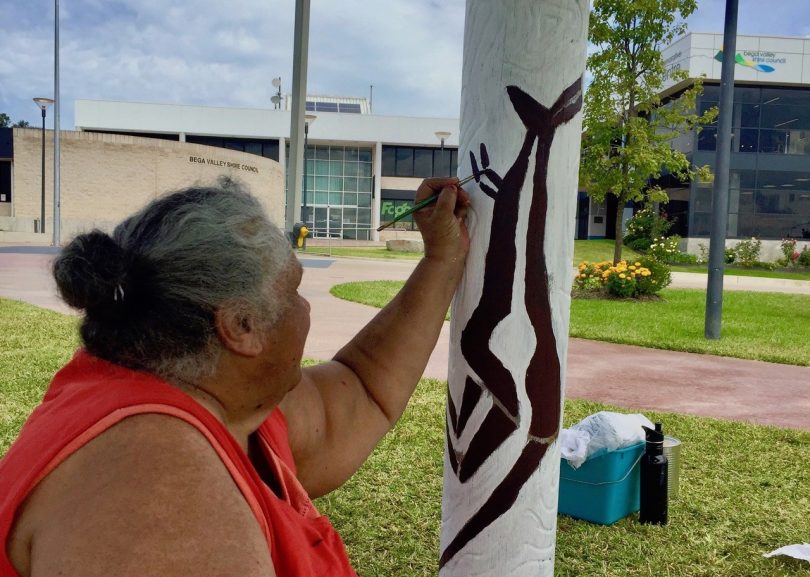
Colleen Dixon. Photo: Ian Campbell
“It’s beautiful that people are stopping and asking me questions about the poles and showing an interest,” says Djiringanj elder, Colleen Dixon.
Colleen has been trying to get a fresh coat of paint on three Aboriginal totem poles in Bega’s Littleton Gardens since Saturday morning.
“I’d be finished by now if I wasn’t doing so much talking,” she laughs.
Speaking to Colleen at lunchtime on Monday, two of the three poles are almost finished.
Like many, I have walked past these totems a thousand times, either in the gardens or in their previous location in front of Bega Valley Shire Council. Never had I noticed the carving of a crayfish before!

Colleen working in her brother’s totem featuring burroo/kangaroo. Photo: Lisa Herbert.
Once Colleen is finished these totems will pop.
“They needed a facelift and we have been getting some very positive feedback,” she says.
One of the poles, originally done by Colleen herself around 20 years ago, features a snake and lists all the tribes of the local area.
“The snake formed the shape of our creeks and rivers, you can see it when you are up in an airplane,” Colleen explains.
The middle pole was originally created by Colleen’s brother David and pays tribute to the burroo/kangaroo.
Good bush tucker Colleen says,” and the singes out of their legs were used for rope, and tieing things and for spears and the bones were used for many things – tools, but women weren’t allowed to ask questions.”
The third pole, featuring the crayfish, is now painted brightly in orange, yellow, and black and was carved by Bermagui’s Jason Campbell.
“The crayfish is part of our food chain, from the mountains to the sea, you pay a fortune for them now.”
Apart from reflecting the town’s Djiringanj culture and history the totems also honour the local environment.
“We are paying respect to our mother earth, this is such a beautiful area.”

Colleen’s daughter Robeen working on Jason Campbell’s totem featuring a carved crayfish. Photo: Lisa Herbert.
Colleen is looking forward to seeing her grandchildren soon, she is saving a spot for their handprints on her totem, and as I leave more people stop to chat.
She wants everyone to know, “Feel free to come and ask questions and sit down and have a yarn.”
“And ask about the indigenous culture and history of this place.”







